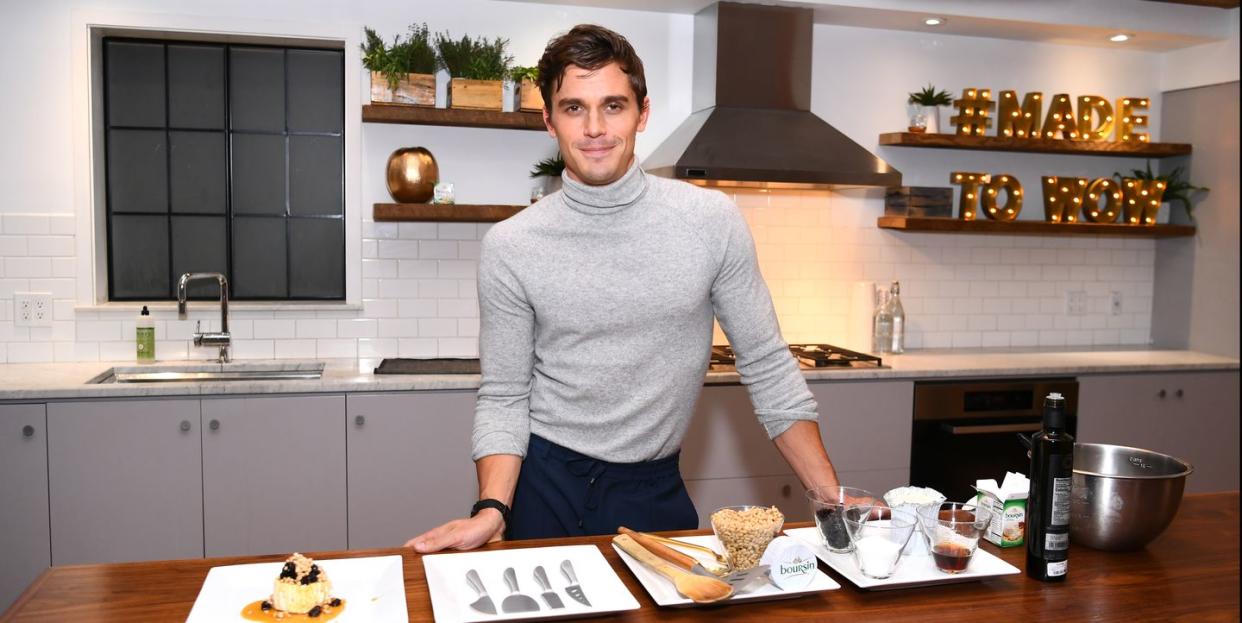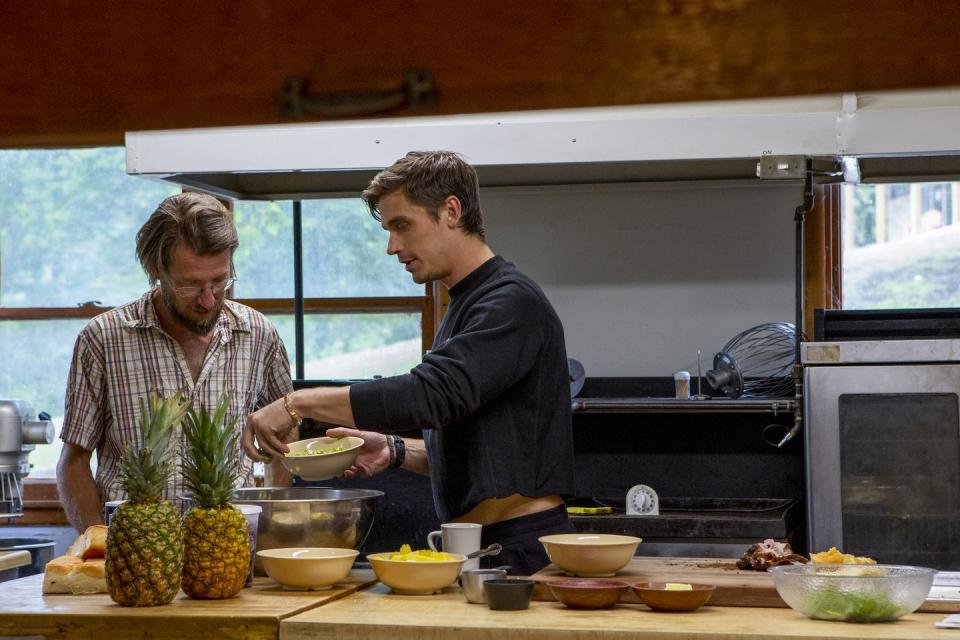Throwing a Dinner Party? Here’s What Queer Eye’s Antoni Porowski Would Do.

When I walk into his hotel room, Antoni Porowski greets me with a wide smile, skips the formalities, and asks me about my glasses, my necklace, my dress. I’m blushing from nerves but also flattery; despite being one of pop culture’s biggest names, his words come out genuine and I’m already feeling refreshed.
I try to pretend like I haven’t been following the Queer Eye star’s every move since his Netflix debut in 2018. I know that yesterday he enjoyed an overstimulated drive through Times Square. This morning, he made himself a barista-quality cortado. Somewhere in between, he did many box jumps and many chest flies and many crunches with his trainer, Damon. I can tell. From my time stalking his pages and binge-watching his show, I also know that Antoni—aside from being a celebrity chef and heartthrob extraordinaire—knows how to throw one hell of a dinner party. On Queer Eye, he not only shows the “heroes” how to craft accessibly decadent meals, he suggests—and demonstrates—the ways in which food is a tool of unity, a medium of congregation, something that ultimately unites us all. “Food allows us to connect with people we may never have considered connecting with,” Porowski says. “Making a beautiful meal is a way of saying ‘I love you,’ or ‘I’m sorry,’ or ‘Hey, I just took time to make something special and customized just for you.’”
If you—like me—are finished binging Queer Eye season four and are jonesing for your next Antoni fix, read on for how the food and wine expert throws his beloved dinner parties.
ELLE DECOR: Tell me about the best dinner party you ever threw. Paint me a picture.
ANTONI POROWSKI: I think I might have thrown one of my favorite dinner parties pretty recently, actually. The guests were a mix of old and new friends. I like to always have something ready for right when guests come in, and it usually involves some kind of dip. A cheesy, artichokey situation usually does the trick, with a LOT of rosemary and a LOT of lemon. Something to nosh on. I used to serve appetizers in the living room, but no matter how hard I try to enforce that and no matter how pretty the platter is, everyone always ends up in the kitchen, and I’ve definitely given into that. I made a charred stone fruit and heirloom tomato salad and some beautiful roasted rainbow carrots with a carrot top pesto—the recipe for the latter and a variation on the former can be found in my cookbook, Antoni in the Kitchen, which comes out September 9th [“shameless plug, he admits”]. I served those with my take on Spaghetti Limon, which is a favorite of mine from Lil’ Frankie’s.

ED: Do you ever let your friends help with the cooking, or is it a one-man job for you?
AP: My friends always love to let me cook, and sometimes I’ll let them partake…I’m such a control freak but I’m trying to get better at that. I’m always like “Ugh, please make sure the onions are all cut in the same size!” I want to be more like Samin Nosrat in the kitchen.
ED: Okay, so you’re finished dinner. What’s next?
AP: I don’t bake, so for dessert I either like to get a really good pastry—which is something you can also ask your guests to bring—or I’ll make an affogato. For the affogato I put my espresso machine [he’s been loving the Saeco Xelsis] on regular coffee mode, and pour it over vanilla gelato, in my favorite vintage porcelain dishes. It’s ready in seconds so you don’t have to worry about being away from your guests for long.
ED: And if you had to choose one thing to always include in a meal, what would it be?
AP: I always joke about the part in Clueless where Alicia Silverstone’s character puts cookies in the oven whenever she has boys over because they smell great. That’s me with garlic. I threw my first dinner party when I was 12 [Porowksi’s favorite thing to do when his parents were away—the rages happened only after dinner] and I would always slow-roast garlic [olive oil drizzle, kosher salt, 350-degrees for 45 minutes], which creates this intoxicatingly orgasmic smell that fills the house. Pair it with a fresh baguette and you’re set.
A post shared by Antoni Porowski (@antoni) on Feb 14, 2018 at 9:09am PST
ED: Now tell me about the worst dinner party you ever threw.
AP: When I lived in my first apartment, in Clinton Hill, Brooklyn, my roommate PJ and I were starting to explore the idea of roasting chicken. We decided to try out a new recipe for a few friends who were coming over…BAD IDEA. Just a quick tip, never try out a recipe for the first time in this context; stick to something you’ve made a million times before. Anyways, the chicken was fine but I took the platter out with my bare hands [Earlier, he mentions, “It's a weird condition that’s totally fine but I don’t feel heat in my fingers”], and it ended up being hotter than I thought. The chicken and my beautiful roasted Jerusalem artichokes and charred onions fell straight to the ground. It was pretty tragic, but we still ate it. It wasn’t very chic. But it was fine. We were students!
ED: Tragedies aside, what’s one thing you should ALWAYS serve at a dinner party?
AP: It’s really hard to avoid cheese. I always try to have one decadent, cheesy type situation. Whether it’s a really nice cacio e pepe, or a charcuterie board to start off, at my dinner parties cheese is always involved.
ED: What goes into this signature Porowski charcuterie board?
AP: I start with a sharp, aged gruyere because it’s nutty and sweet and completely delicious. I love to also include an unpasteurized cheese [something most people “can’t get in the U.S. because it’s illegal,” but of course, Porowski knows a guy]. With unpasteurized cheese, the best variations are the really creamy ones like Brillat-Savarin, because they have a buttery quality that looks like a brie but melts so beautifully. I round it out with a firm American cheese, like a classic Cabot cheddar. It’s really important to have variety with a charcuterie board. I then add in some version of a protein, and at least two veggie sides.
ED: What’s one thing you should NEVER serve at a dinner party?
AP: Chicken liver is very polarizing; people either really love it or really hate it. [But if you’re asking, Porowski likes it sautéed and blackened, served with fried onions.]
ED: Is there anything you’ve witnessed at a dinner party that totally kills the vibe?
AP: Spending too much time in the kitchen or serving each plate separately instead of family style. When people try to make things too perfect or meticulous, it takes away from what makes a good dinner party. When the host gets stressed, the guests get stressed too, so even if I have to fake it, I try to remain calm.
ED: Aside from food, creating a great ambience is key to throwing a hit party. How do you personally make everyone feel comfortable and entertained, from start to finish?
AP: I do it with candles EVERYWHERE. I dim the lights. I offer them a drink right when they come through the door. And since I want people to sit and enjoy their time at the table, the busboy in me always has an eye out for refilling empty water glasses. Something that I also love to do is personalize everyone’s coffee orders. My Saeco Xelsis makes 15 different drinks that can be customized to taste, so I can take everyone’s order and really make my guests feel special.
ED: You want your table settings to be beautiful, but somebody’s bound to knock over a glass of red wine or spill food. How do you set your table so it doesn’t just end up all going in the garbage or to the cleaner?
AP: I have an old farm table from the 1700s that has a beautiful grain on the wood, so I actually don’t cover it up (knowing that the table is 250 years old, I figure it can stand the test of a dinner party). I keep my settings simple but chic, with dinnerware from Heath Ceramics, a selection of linen napkins from RW Guild, and my investment in sterling Puiforcat Chantaco flatware. After those, I’ll finish the whole thing off with some fresh flowers I picked up from the market earlier that day, so the overall effect is effortless but elegant.
ED: On Queer Eye, when you teach these “heroes” how to cook, there’s so much more to it than simply equipping them with culinary skills. Beyond the act of cooking, what’s important?
AP: Being raised in a dysfunctional family myself, the one time we really got along was when we sat down and broke bread and had a family-style meal. That’s what I try to convey to my heroes. The physical act of reaching into something in my life and sharing that is so important. Oftentimes, these heroes have very different views from me, but food is an opportunity to put all of that to the side and realize we’re much more similar than we are different. I’m not here to judge you, I’m here to encourage you to nurture what your values are through cooking.
You Might Also Like

